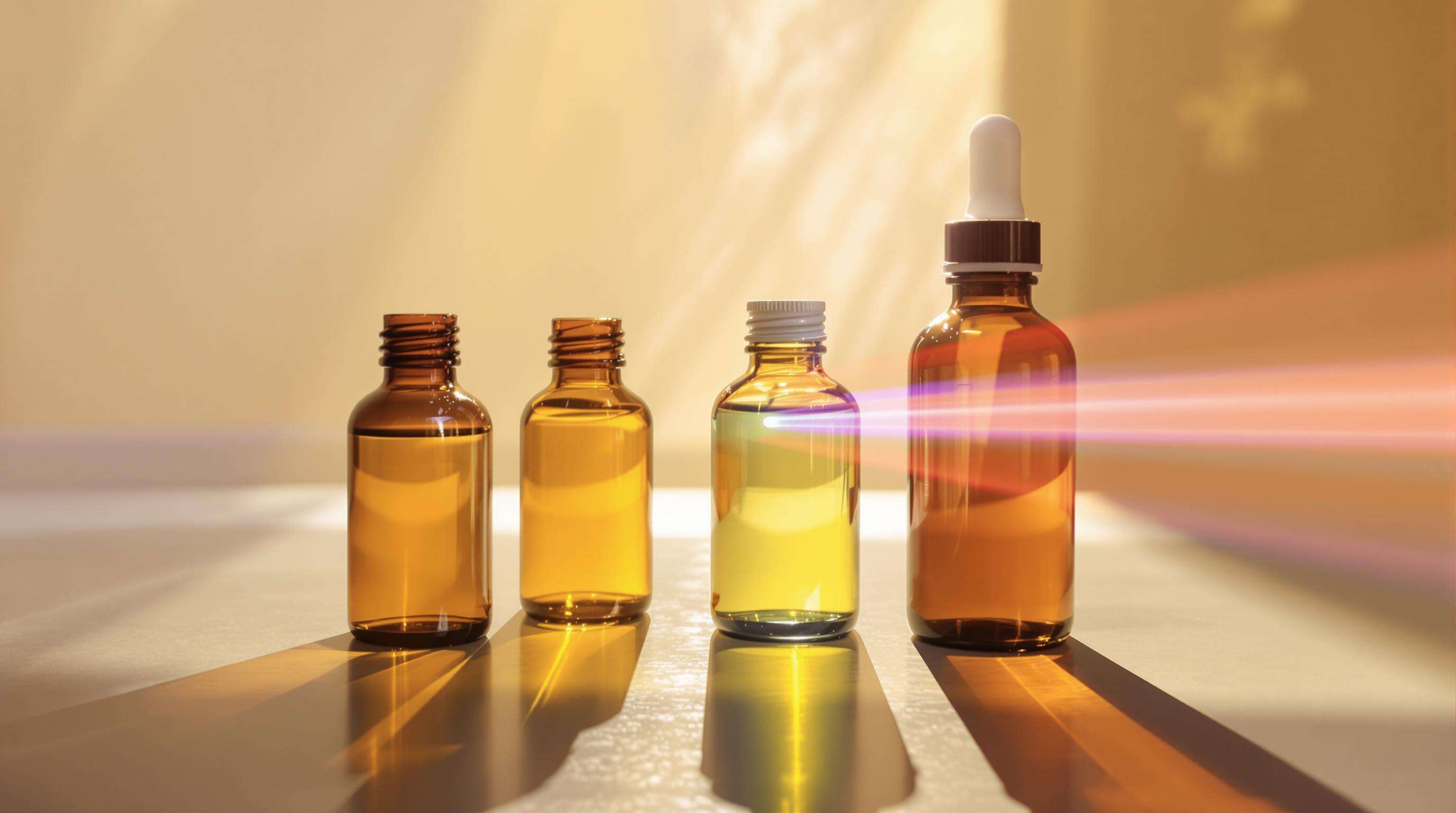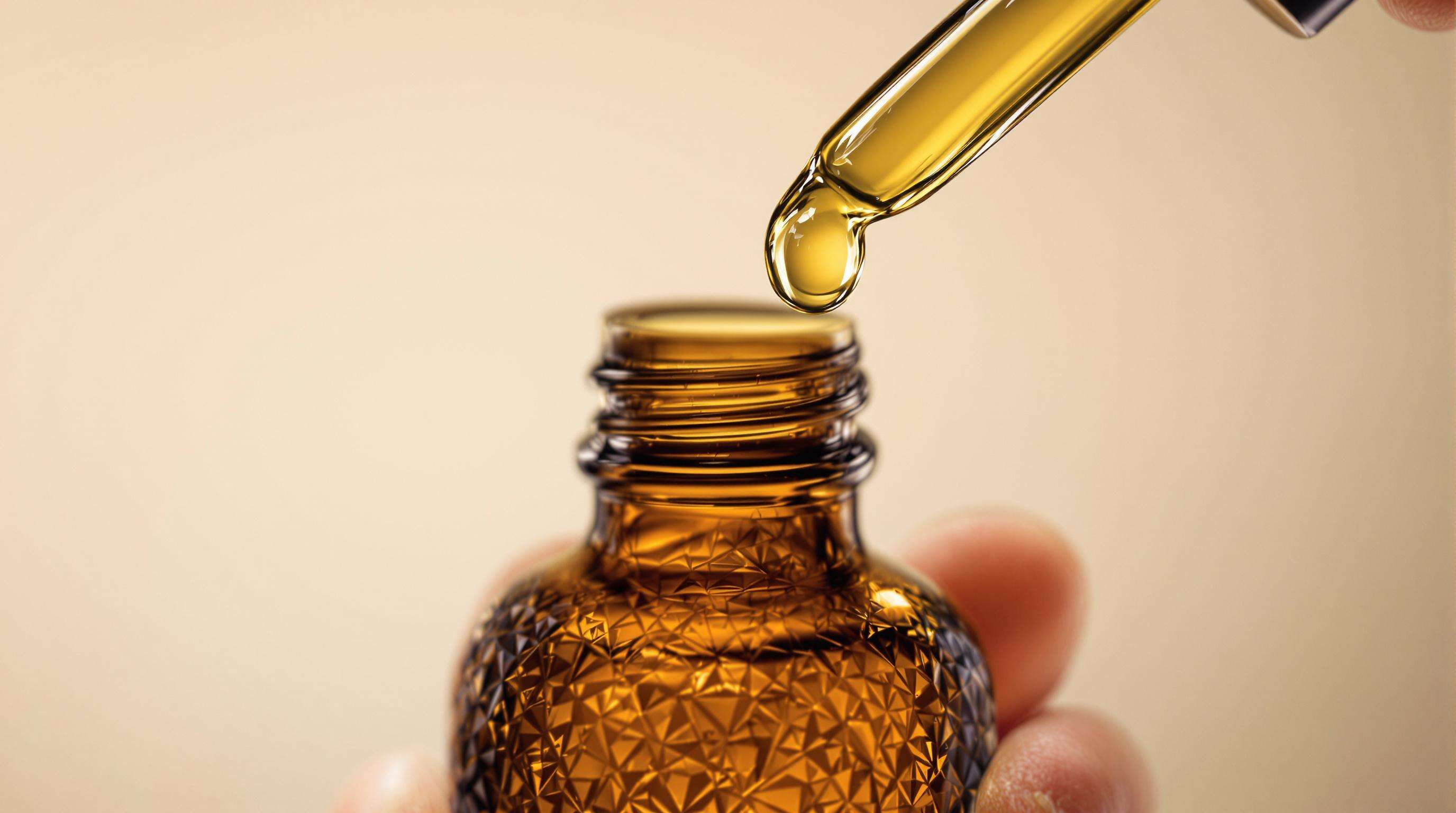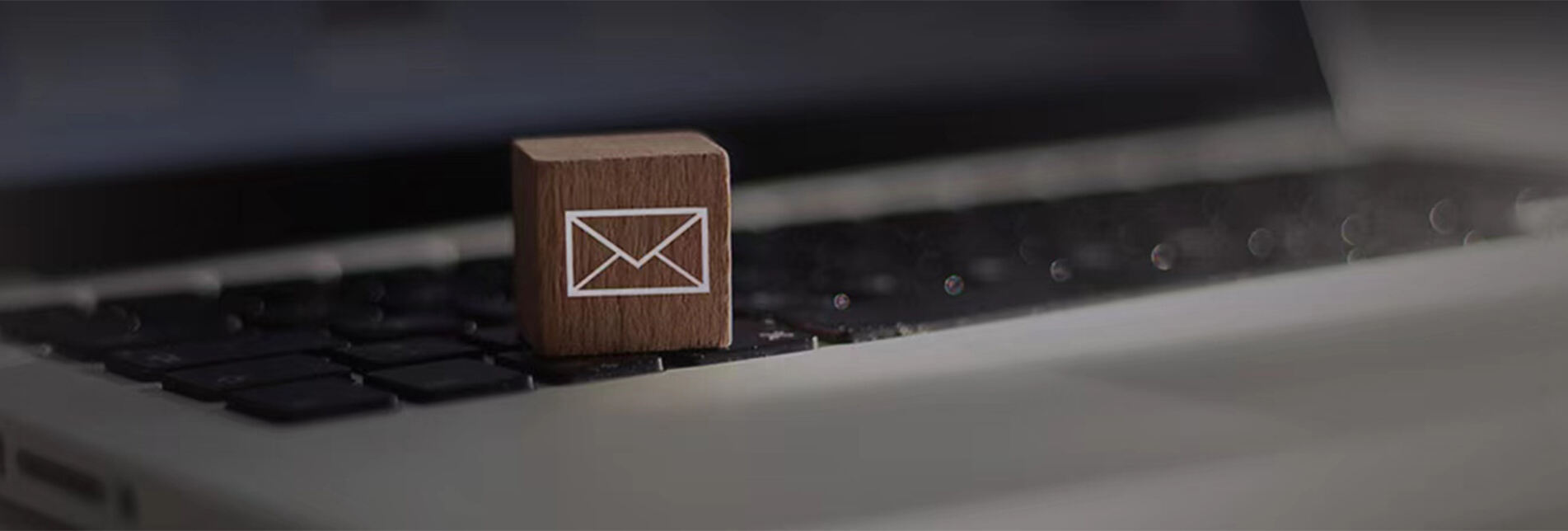Mga Bote ng Dropper Oil sa Amber Glass para sa UV Protection at Shelf Appeal
Paano Nakapagbibigay ang Basong Amber ng UV Protection para sa Mga Langis na Sensitibo sa Liwanag

Ang Agham sa Likod ng Basong Amber at Ang Mga Katangian ng Wavelength Filtering Nito
Ang baso na amber ay talagang humaharang ng humigit-kumulang 90 hanggang 95 porsiyento ng mapanganib na UV rays dahil ito ay naglalaman ng iron oxide at ilang sulfur compounds. Ang mga materyales na ito ay nagtatrabaho nang sama-sama upang sumipsip ng mapanganib na wavelength na nasa saklaw na 300 hanggang 500 nm. At hulaan mo ano? Iyon mismo ang saklaw na nagdudulot ng pinakamalaking pinsala sa mga langis na sensitibo sa liwanag. Talagang mahalaga ang proteksyon na ibinibigay ng basong amber kapag pinag-uusapan natin ang isang bagay na tinatawag na photodegradation. Pangunahing nangyayari ito kapag ang UV light ay nagsisimulang masira ang mga mahahalagang bagay tulad ng terpenes na matatagpuan sa mga mahahalagang langis. Sa paglipas ng panahon, nangangahulugan ito na nawawalan ng epektibidad ang mga langis at hindi na gaanong maganda ang pagganap nito ayon sa pananaliksik na inilathala sa Journal of Pharmaceutical Sciences noong 2022.
Clear Glass kumpara sa Amber Glass: Pagpapanatili ng Sariwa, Lakas, at Tagal ng Imbakan
Ang mga langis na naka-imbak sa malinaw na salamin ay nagdegradasyon ng tatlong beses na mas mabilis kaysa sa mga nasa kulay ambar na salamin sa ilalim ng ambient light. Ang mga langis na batay sa citrus, halimbawa, ay nawawala ang 40% ng kanilang limonene content sa malinaw na lalagyan pagkatapos ng 60 araw, kumpara sa mas mababa sa 10% sa kulay ambar na salamin.
| Uri ng Salamin | UV Blocking % | Bawasan ang Rate ng Oxidation | Pag-ekspand ng Shelf Life |
|---|---|---|---|
| Malinaw na salamin | 0% | Baseline | 0—3 buwan |
| Berde na Salamin | 30—50% | 25—40% | 6—9 buwan |
| Amber glass | 90—97% | 72—85% | 18—24 na buwan |
Sapat na ba ang Amber Glass? Pagtatasa ng mga Kailangan sa Karagdagang Proteksyon sa UV
Ang amber glass ay nag-aalok ng pinakamahusay na proteksyon para sa karaniwang mga kalakalan at kapaligiran sa bahay, ngunit ang karagdagang mga pananggalang ay inirerekomenda para sa matitinding kondisyon tulad ng pagpapadala sa ekwador o matagal na pagpapakita sa ilalim ng maliwanag na ilaw. Isaalang-alang ang paggamit ng pangalawang mga opaque na sleeve, imbakan na may proteksyon sa UV, o aluminum na pang-iba pang produkto na may kalidad sa parmasya.
Papel ng Hindi Reaktibo at Hindi Marikit na Mga Materyales sa Pagpigil ng Oksihenasyon
Ang amber glass ay bumubuo ng isang hindi marikit na barrier na may rate ng paglilipat ng oksiheno na 0.0015 cc/m²/araw—mas mababa kaysa 0.5 cc/m²/araw na nakikita sa mga plastik na lalagyan. Ang halos sero na pagpapalit ay tumutulong sa pagpigil ng oxidative rancidity sa mga langis na mayaman sa taba tulad ng rosehip seed at marula, upang mapreserba ang kanilang integridad sa kemikal sa paglipas ng panahon.
Pagpapalawig ng Potensya at Tagal ng Imbakan ng Mga Mahahalagang Langis sa Amber Dropper na Lalagyan
Paano Pinapanatili ng Amber Glass ang Kemikal na Katatagan ng Mga Mahahalagang Langis sa Paglipas ng Panahon
Ang amber glass ay nagfi-filter ng mga haba ng light wave sa pagitan ng 470 at 500 nm na lalo pang nakakapinsala sa terpenes at esters, at binabawasan ang photodegradation ng halos 83% kumpara sa karaniwang clear glass ayon sa isang pag-aaral na nailathala sa Journal of Essential Oil Research noong 2023. Ang mismong materyales ay gawa sa di-nagre-react na silica na nagpapigil sa mga ion na tumagas sa loob ng laman, na maari namang mapabilis ang oxidation. Mga pagsusulit na isinagawa sa loob ng labindalawang buwan ay nagpapakita na ang uri ng packaging na ito ay nakapagpapanatili ng halos 98 porsiyento ng lakas ng produkto ayon sa pag-aaral ng Natural Product Preservation Alliance noong 2022.
Case Study: Lavender Essential Oil Preservation in Amber Dropper Bottles
Noong 2022, tiningnan ng mga mananaliksik kung paano nagtatag ng lavender oil kapag inimbak ito tulad ng nararapat sa mga tindahan, at nakakita sila ng isang kakaibang bagay. Ang mga sample na nakatago sa mga bote na itim na luntian ay nanatili pa rin ng humigit-kumulang 94% ng kanilang linalool acetate pagkalipas ng 18 buong buwan, na isa sa mga pangunahing sangkap na responsable sa mga therapeutic effect nito. Samantala, ang mga nasa salaming malinaw ay nanatili lamang ng humigit-kumulang 67%. Pagdating sa oxidation, mas malinaw ang kuwento ng mga numero. Ang mga lalagyan na kulay luntian ay nagpakita ng mas magagandang resulta kung saan ang mga halaga ng peroxide ay sumukat lamang ng 15 mEq/kg, habang ang mga hindi protektado ay umabot ng 110 mEq/kg. Ang mga natuklasan mula sa AromaChemistry Journal ay sumusuporta sa kung ano ang alam na ng maraming mahilig sa essential oil tungkol sa wastong pag-iimbak na nagpapaganda ng preserbasyon ng kalidad.
Pinakamahusay na Kadalasan para sa Mahabang-Term na Imbakan ng Mga Light-Sensitive na Pormulasyon
- Punuan ang mga bote sa 85—90% ng kapasidad upang bawasan ang oxygen headspace
- Itago nang nakatayo sa 15—20°C (59—68°F), iwasan ang pagbabago ng temperatura na nagpapabilis ng pagkasira
- Gumamit ng dropper na may tamper-evident at hermetic seals upang bawasan ang pagkawala ng volatile organic compound (VOC) mula 12% hanggang 2% taun-taon
- Pagsamahin ang amber glass kasama ang pangalawang balatkayo tulad ng UV-coated na karton para sa mga produkto na may lay-away na higit sa 24 na buwan
Disenyo at Tampok ng Dropper Oil Bottles para sa Tumpak na Dosis at Kasiyahan ng Gumagamit

Mekanismo ng Dropper sa Amber Glass: Tinitiyak ang Tumpak na Sukat at Madaling Paggamit
Ang mga bote ng amber glass dropper ay nagtataglay ng mga katangian ng tumpak na pagbubuhos kasama ang mahusay na proteksyon laban sa UV para sa mga sensitibong laman. Ang mga modernong disenyo ng dropper ay may mga sistema na kontrolado ng hangin na nagbibigay ng mga tumpak na pagbubuhos na nasa pagitan ng 0.05 hanggang 0.1 mililitro, na gumagana nang maayos para sa mga bagay tulad ng mahahalagang langis at mga serum sa mukha. Hindi sapat ang mga tradisyunal na goma na pipeta kapag ginagamit sa mga acidic na sangkap tulad ng lemon o tea tree oil, ngunit ginagamit ng mga bagong dropper ang mga espesyal na inert na polymer. Ayon sa isang pagsusuri sa Packaging Technology noong nakaraang taon, ang pagpapalit na ito ay talagang binabawasan ang problema sa pagtagas ng mga 72%. Bukod pa rito, ang mga surface ng bote ay may magandang texture para sa mas mahusay na paghawak, habang pinipigilan pa rin ang halos lahat ng mapanganib na UV rays sa 99% na epektibidad. Ito ay nangangahulugan na ang mga tao ay nakakakuha ng tumpak na dosis tuwing gagamitin ang produkto, nang hindi nababahala sa pagkasira nito dahil sa pagkakalantad sa liwanag.
Pagsasama ng Tungkulin at Integridad ng Materyales sa mga Aplikasyon sa Kosmetiko
Ang mga de-kalidad na bote ng amber glass dropper ay ginawa mula sa Type III borosilicate glass na kayang hawakan ang mga pagbabago sa temperatura sa panahon ng mga proseso ng isterilisasyon nang walang pag-crack. Ang salamin ay hindi rin tumutugon sa mga sensitibong sangkap tulad ng retinol o bitamina C, na ginagawa itong perpekto para sa mga produkto ng skincare. Ang mga bote na ito ay may mga advanced na sealing system na may kasamang polypropylene caps na ipinares sa mga silicone gasket. Ipinapakita ng mga pagsusuri na ang mga seal na ito ay nagpapanatili ng mga rate ng paglipat ng oxygen sa ilalim ng 0.005 cc bawat pakete bawat araw, na nangangahulugang ang mga produkto ay mananatiling sariwa nang humigit-kumulang 30 hanggang 50 porsiyentong mas matagal kapag nakalantad sa liwanag. Ang nagpapatingkad sa mga container na ito ay kung paano nila natutugunan ang lahat ng mga kinakailangan na itinakda ng mga pamantayan ng EU Cosmetic Regulation (EC) 1223/2009. Dagdag pa, pinahahalagahan ng mga customer ang ginhawa ng mga ergonomic na bulb dropper at ang makinis na pakiramdam ng frost finished surface na nagbibigay sa kanila ng karangyaan sa araw-araw na paggamit.
Amber Glass Packaging bilang isang Strategic Choice para sa Brand Identity at Market Appeal
Persepsyon ng Konsyumer at Visual na Epekto ng Amber Glass sa Kredibilidad ng Produkto
Pagdating sa packaging ng produkto, ang amber glass dropper bottles ay nagpapahiwatig ng malinaw na mensahe tungkol sa kalidad. Ayon sa isang kamakailang survey mula sa Beauty Packaging, halos tatlong-kapat ng mga tao ang nag-uugnay sa uri ng salamin na ito sa isang bagay na espesyal at mabuti ang pagkakapreserve. Hindi lang basta maganda ang malalim na kulay na amber. Ayon sa mga parehong pamantayan na ginagamit sa medisina, binabara ng salamin na ito ang karamihan sa masamang UV light, na tumutulong upang mapanatiling ligtas ang mga produkto. Para sa maraming customer, lalo na yaong regular na gumagamit ng essential oils, mahalaga ito. Halos anim sa sampung mahilig sa essential oils ay talagang pinipili ang mga lalagyan na gawa sa amber glass dahil naniniwala sila na hindi gaanong nangangalaga ang plastik sa langis sa paglipas ng panahon. Talagang nakakaapekto ang ganitong pag-iisip sa mga pinamimili ng mga tao kapag bumibili ng kanilang paboritong natural na produkto.
Trend Analysis: Mga Premium na Brand ng Skincare na Sumusunod sa Paggamit ng Amber Glass Dropper Bottles
Mga branded na produkto sa pangangalaga ng balat ay nagsimulang gumamit ng maliit na bote na gawa sa amber glass noong 2021, na may pagtaas ng humigit-kumulang 40% ayon sa pinakabagong pananaliksik tungkol sa uso sa pag-packaging noong 2025. Gustong-gusto ng mga brand na ito ang paraan kung saan napipigilan ng amber glass ang masamang UV rays habang nagbibigay ng hitsura ng tradisyunal na botika na kinagigiliwan ng mga mamimili. Bukod pa rito, ang salamin ay hindi nagrereaksyon sa mga sangkap, na isang mahalagang aspeto para sa mga produktong 'clean beauty' na nangangailangan ng matatag na pH level. At syempre, ang mismong dropper ay nagpapadali sa paglalagay ng mahal na serum nang hindi nasasayang ang mahalagang patak. Kaya naman hindi nakapagtataka kung bakit napakasikat ng pagpipiliang ito sa mga premium na linya ng skincare.
Balanseng Pinagsama ang Estetika, Gamit, at Pagmamapanatag para Paunlarin ang Halaga ng Brand
Ang mga bote na gawa sa amber glass na may dropper ay talagang nakakatugon sa tatlong mahahalagang aspeto nang sabay-sabay: mabisa ang gamit, maganda ang itsura, at mas nakababagay sa planeta. Ang mga bote na ito ay nakakablock ng mapapaminsalang UV rays habang ang kanilang leak proof na euro style droppers ay nagpapaganda sa kanilang maaasahan sa pang-araw-araw na paggamit. Bukod pa rito, mayroong isang bagay na talagang nakakaakit sa kanilang makulay na kulay-amber na nakakatayo sa mismong istante ng tindahan. Ang nagpapahalaga sa mga lalagyan na ito ay kung gaano karaming mga customer ang nagmamahal sa kanila. Ayon sa mga pag-aaral, ang mga tao ay itinuturing na ang mga produkto sa amber glass ay may halagang 33 porsiyento mas mataas kaysa sa karaniwang opsyon sa pagpapakete. At huwag kalimutan ang aspetong pangkalikasan. Maraming mga skincare company na may pagodulo sa kalikasan (halos 28%) ang nagsimulang gumamit ng mga sistema ng pagpapalit upang maisakatuparan ang kanilang pangako na bawasan ang basura at itatag ang mga mapanatiling gawain sa buong kanilang operasyon.
Seksyon ng FAQ
Bakit pinipili ang amber glass kaysa sa clear glass sa pag-iimbak ng mga langis?
Inirerekomenda ang amber glass kaysa sa clear glass dahil ito ay nakakablock ng 90 hanggang 97 porsiyento ng mapinsalang UV light, na lubos na nagpapababa ng rate ng oxidation at nagpapahaba ng shelf life.
Anong mga uri ng langis ang pinakakinabangan sa pag-iimbak sa amber glass?
Ang light-sensitive na langis tulad ng essential oils, citrus-based oils, at langis na mayaman sa lipid tulad ng rosehip seed at marula ay pinakakinabangan sa pag-iimbak sa amber glass dahil sa mga katangian nitong protektahan mula sa UV.
Nagbibigay ba ng ganap na proteksyon ang amber glass laban sa UV light?
Bagama't nagbibigay ang amber glass ng sapat na proteksyon laban sa UV, maaaring kailanganin ang karagdagang hakbang tulad ng opaque sleeves o UV-filtered storage lalo na sa matinding kondisyon.
Nakakaapekto ba ang amber glass sa kemikal na katatagan ng mga langis na naka-imbak dito?
Nagpapanatili ang amber glass ng kemikal na katatagan ng mga langis sa pamamagitan ng pagpigil sa pagtagas ng ions sa loob ng nilalaman nito, kaya binabawasan ang oxidation.
Nakaraan :Wala
Susunod: Mga Bote ng Glass Lotion Pump na may Post-Consumer Recycled Metal Springs




